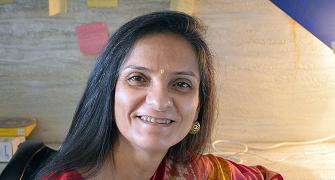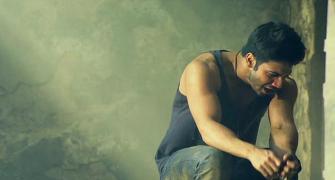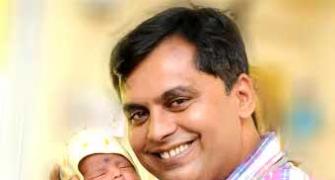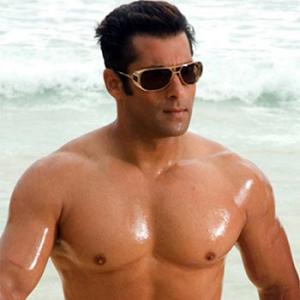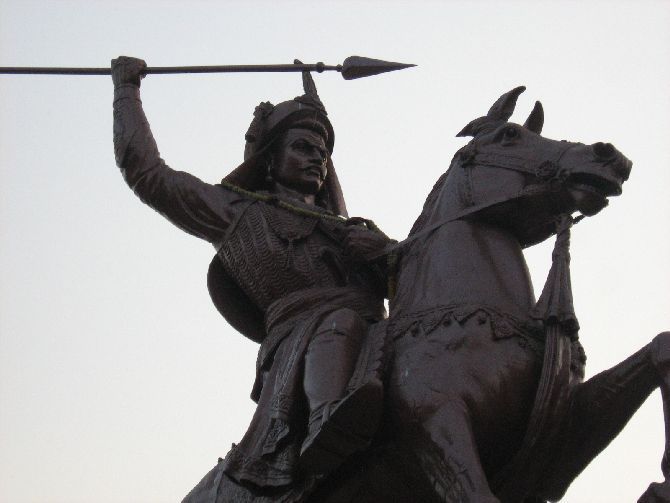
Bajirao, an unorthodox leader, faced much opposition during his lifetime from the Brahmins of Pune. In the last hundred years or so, he has been ignored due to caste politics in Maharashtra where he has become a 'non person' for having been born a Brahmin, says Colonel Anil A Athale (retd).
Field Marshal Bernard Montgomery -- the British war hero who defeated Field Marshal Erwin Rommel at the Battle of El Alamein in 1942 -- was a keen student of military history. Field Marshal Montgomery observed that Bajirao was possibly the finest cavalry general ever produced by India. Thanks to the Bollywood film, Bajirao Mastani, and the controversy surrounding it, this forgotten hero of Indian history has had a public resurrection of sorts.
Bajirao, an unorthodox leader, faced much opposition during his lifetime from the Brahmins of Pune (he ate meat and wanted a thread ceremony performed for his son Shamsher Bahadur born to his Muslim wife).
In the last hundred years or so, he has been ignored (and even vilified with a nasty outfit organising a 'spitting agitation' against him) due to the caste politics in Maharashtra where he has become a 'non person' for having been born a Brahmin. Never mind, the historical fact that he promoted talented Maratha and Dalit soldiers in his army purely on merit.
Some have used these controversies to further their warped views by equating the Marathas with the Mongols! One commentator wants Indians to believe that the Gaekwads of Baroda, the Scindias of Gwalior and the Holkars of Indore ruled central and western India without any popular support. Relying mainly on either hostile British or Mughal sources, this individual has rubbished Bajirao and the Marathas.
The 'real' reason for the discomfort is that memories of Bajirao bring into focus the battlefield defeats of the Mughals and the Nizam, long kept hidden from the public by the wizard of Allahabad and his discovery of India.
The history of Bajirao challenges the notion that the British seized control of India from the Mughals and not the Marathas, the 'real' rulers of most of India in the 18th century.
In his brief military career spanning 20 years, Bajirao never lost a battle.
Balaji Vishvanath, the first Maratha Peshwa (prime minister), died on April 2, 1720 at Saswad, close to Poona. His eldest son Bajirao was barely 20 at that time.
Chhatrapati (king) Shahu, who had a very high regard for Balaji, kept his promise and appointed Bajirao Peshwa. Bajirao, though young, already had sufficient experience in his father's company. Despite opposition from many older generals in his court, Shahu reposed his faith in the young Bajirao.
A keen and dashing horseman, Bajirao organised the Marathas into an efficient fighting machine based on the concept of fast moving cavalry. His army was composed solely of cavalry with virtually no baggage train to slow it down.
Bajirao lived with his soldiers, shared their hardships and always led from the front.
An appreciative and shrewd commander, he gathered around him competent men like Shinde, Holkar, Gaekwad, Pawar and Jadhav.
By 1732, the Marathas had already established their control over all of Gujarat. Further progress in that direction was not attempted as Bajirao did not want to clash with the kingdom of Udaipur of the Sisodia Rajputs, from which clan Shivaji claimed ancestry. Bajirao is reported to have requested the Rana of Udaipur to become the emperor of India to head what he called 'Hindu Padpadshahi' (Hindu empire).
The events of this period are of great historical significance, as only once earlier, during the time of Pulkeshin the Great in 606 AD, had victorious armies travelled from the south to the north. For most of the time in history, the flow had been in the reverse direction.
This Maratha sway was to last right till the 19th century when ultimately their power was replaced by the British. These daring feats of the Maratha cavalry caught the imagination of everyone in Maharashtra and led to an enduring attraction for this mode of warfare.
Whenever pressed by adversity, the Marathas were prone to repeat the example of Bajirao and his nimble footed cavalry. Yeshwantrao Holkar harassed the British in a similar manner in 1804-1805 and in the final Indian attempt to defeat the British militarily, Tantiya Tope was to follow the same mobile warfare strategy in 1857-1858 in the first Indian War of Independence.
The battle of Palkhed in which Bajirao humbled Nizam ul Mulk, the most powerful Mughal general of the 18th century is the best illustration of his use of cavalry. In 1726, the Nizam left Delhi for the south with a powerful army that was well served with artillery, the principal Mughal arm at that period.
In a letter to Sawai Jaisingh, the Nizam wrote, 'The Marathas have permanently planted their claws in imperial territory. My purpose is to destroy Shahu's power.'
The Nizam sought and got the help of Shahu's cousin, Sambhaji of Kolhapur who had staked a claim to the Maratha throne. Seeing the danger Shahu declared war on October 13, 1727, on the Nizam. The Nizam immediately accepted the challenge and moved in the direction of Satara, Shahu's capital.
Many Maratha generals deserted Shahu and joined Sambhaji who captured Poona and declared himself the rightful king of the Marathas. Shahu and his family took shelter at the Purandar fort, south of Poona.
Bajirao was in Khandesh at that time and Shahu summoned him urgently to return and defend the capital. Instead, Bajirao proposed and carried the offensive right into the Mughal areas. First, he marched north and captured Gujarat. The Mughal governor of that province readily joined him.
Next, he attacked the Nizam's rear in Malwa, thus cutting him off from Delhi. By February 14, 1728, Bajirao's cavalry was poised to threaten Aurangabad, the Nizam's capital as well as the rich town of Burhanpur. The Nizam could no longer ignore this threat. He closed his campaign in the Poona-Satara area and moved to meet Bajirao.
In the middle of February, the Nizam's army crossed the Godavari river in the vicinity of Aurangabad. The Nizam felt he was pursuing the defeated Marathas.
When news arrived of Bajirao having been sighted south of the Godavari, the Nizam re-crossed the river, this time leaving behind his powerful artillery, which was proving a hindrance to swift movement.
On February 25, 1728, the Nizam and his by now tired army found itself trapped in the difficult area at Palkhed, 20 miles west of Aurangabd and 10 miles east of Baizpur. The Marathas suddenly turned back and attacked the Nizam's army. Bajirao sent messages to Malhar Rao Holkar and Ranoji Shinde to quickly converge on Palkhed.
The Nizam's army was now totally cut off from any supplies. As the summer advanced, even water became scarce. All this while, the Mughals were daily losing men to the Marathas in skirmishes.
Finally on March 6, the Nizam capitulated and agreed to stiff terms.
During this difficult war, the king asked Bajirao to go on the defensive. Bajirao replied, 'To cut a tree you do not cut all the branches and the trunk -- the best way is to strike at the roots.' Bajirao used the movement of his cavalry to bring the Nizam into a situation of disadvantage. His scattered divisions would concentrate at the chosen point. His sudden turn to offensive, at the right moment, was his forte.
Moving over 40 kms a day, without any warning, the Maratha cavalry appeared outside Delhi in the first week of April 1737. Bajirao's dash to Delhi in 1737 was so sudden that panic gripped the city. Boats were kept ready for the escape of the Mughal emperor.
On April 9, 1737, Bajirao and his cavalry camped near Talkatora. The camp fires lit by the Marathas could be seen from the ramparts of the Red Fort.
Delhi was not without resources. There was a substantial Mughal and Rajput cavalry numbering 12,000 and infantry armed with firearms, accounted for nearly 20,000. There were a substantial number of heavy guns close at hand. Mughal generals experienced in fighting the Marathas dissuaded the emperor from personally taking charge by making disparaging remarks against the Marathas -- dismissing them as mere farmers turned soldiers. Nearly 4,000 troops were left to guard the emperor with arrangements made for a quick getaway.
The Mughal armies were led by Amir Khan, a favourite young courtier, and the Mughal troops consisted of mainly Pathans, Turks and other Central Asian peoples. On the midnight of April 9\10, 1737, the Mughal forces began entrenching themselves from the gates of the city towards the Talkatora grove. Guns were placed at regular intervals to lend strength to the defences.
By dawn the Mughals were ready to receive the Maratha attack. But none came as the fleet footed Maratha cavalry had already withdrawn southwards.
The Mughal commander Amir Khan was quite content to remain on the defensive, but not many of the younger elements. Mir Hasan Khan at the head of 2,000 cavalry of the imperial bodyguard left the city without orders and came to the battle arena. Accusing the older men of cowardice, he along with a further addition of young courtiers rashly charged on the Marathas.
Bajirao let them come within the range of his light swivel guns that discharged arrows, and ordered the Marathas to retreat even further, thus drawing the Mughals more than 2\3 miles further from Talkatora into the open plains.
At this point, the Marathas suddenly turned back and fell on the Mughals with their lances and straight swords. It was a total rout. At the cost of very few Maratha casualties and only one officer being slightly wounded, Bajirao routed the charging Mughals.
Over 12 Mughal nobles were killed and over 600 soldiers lost their lives. Bajirao collected a war booty of 2,000 horses, one elephant and several firearms. The emperor immediately opened parleys and the Marathas virtually secured the provinces of Malwa as well as right to 1\4 income (chauth) of several provinces.
In 1739, instigated by some Mughal courtiers, Nadir Shah invaded India. He was helped in the Punjab by the Nizam and other Mughals who wanted the Marathas to be ousted from Delhi at all costs. Nadir Shah obliged them and in the bargain looted wealth worth nearly Rs 100 crore. He also took away with him the famous Peacock Throne as well as the Kohinoor diamond.
The Marathas were then engaged in a fierce war with the Portuguese. In April, as the news reached of Bajirao moving towards Delhi, Nadir Shah left for Iran on May 1, 1740. Bajirao died on the banks of the Narmada on April 28, 1740 while on his way to Delhi on the urgent summons of the Mughal emperor even as Delhi was captured by Nadir Shah of Iran.
One of the big 'ifs' of Indian history is Bajirao's untimely death on the way to Delhi to take on Nadir Shah. Maybe the Kohinoor and Peacock Throne would have still been in India.
IMAGE: A statue of Peshwa Bajirao I in Pune. Photograph: Kind courtesy Amit20081980/Wikimedia Commons
Based on Colonel Athale's book, Marathas Struggle for Empire, published by Reliance Publishing House, New Delhi.
Colonel Anil A Athale (retd) is a military historian who studied the Maratha struggle for empire as an Institute for Defence Studies and Analysis Fellow.

